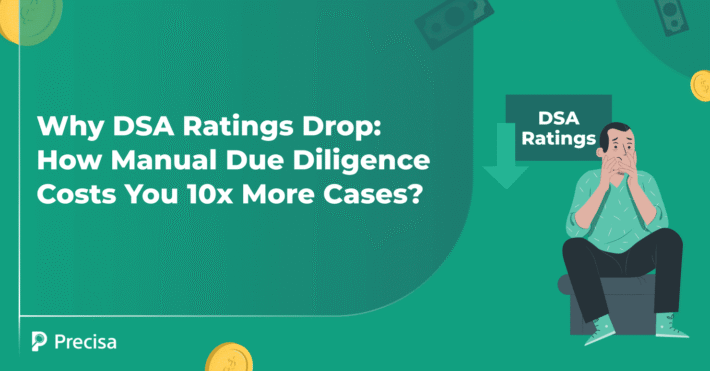Analysing the Relationship Between Loan Terms and DPD in Finance

As lenders scale their operations, it becomes more important for them to gauge a borrower’s creditworthiness with accuracy. Otherwise, it can lead to the growth of non-performing assets (NPAs) and more delinquencies.
As of March 2024, the percentage of gross non-performing assets (GNPA) in India was as follows: 1.2% per personal loan, 6.2% in the agricultural sector, 2.7% to the services companies, and 3.5% for industry.
Worryingly, the delinquency levels for retail borrowers taking personal loans of less than INR 50,000, also remained high.
Both NPAs and delinquencies eat into the revenues and profitability of lenders. This is where access to Days Past Due or DPD in finance data, a key financial metric, can help lenders understand a borrower’s past credit behaviour.
By taking this data into consideration in the underwriting process, lenders can predict a borrower’s future behaviour more accurately. Let’s explore how.
What Is DPD in Finance?
Every month, borrowers need to make their Equated Monthly Installment (EMI) or credit card bill payments as per the due date. DPD in finance refers to the number of days after which a borrower makes an Equated Monthly Installment (EMI) or credit card bill payment post the due date.
The formula used to calculate DPD is simple, and as follows:
DPD = Date on which payment is made – Due Date
Say, the payment due date is the 4th of the month. However, the borrower has only made a payment on the 20th of the month. In this case:
DPD = 20 – 4 = 16
Role of DPD in Finance in Credit Reports
DPD in finance is an important metric that features in credit reports. It is considered in the calculation of a consumer’s credit score, along with other data points.
In India, a consumer’s CIBIL Score serves as a measure of creditworthiness. Hence, CIBIL reports, typically, consider a consumer’s DPD for the last 36 months.
As a rule of thumb, the higher the DPD, the lower the CIBIL score.
Therefore, the DPD factor directly impacts a consumer’s creditworthiness, and in turn, their ability to secure a loan at affordable rates.
Impact of DPD in Finance
Here’s how DPD in finance plays an important role in helping lenders gauge a borrower’s future loan repayment behaviour:
Effect on Loan Terms and Conditions
When a borrower takes a loan, they seek the most optimal loan terms. They want to bring down the overall cost of the loan and ensure that monthly EMIs align with their monthly cash flows. Most borrowers also prefer not to pledge any collateral as security.
On the other hand, lenders need to ensure that they are managing risk effectively, capitalising on market opportunities, and offering loan terms that are competitive.
Customers with a lower DPD can aspire for more favourable loan terms, as it demonstrates their ability to make payments on the due dates. Hence, DPD in finance can play an instrumental role in helping lenders set the right loan terms. By doing so, they can balance risk with rewards.
Key Loan Terms and Conditions
Loan terms and conditions essentially cover the following aspects:
- Principal: The core amount of money the borrower needs.
- Interest Rate: The percentage charged on top of the principal, representing the lender’s cost of lending.
- EMI: The fixed amount the borrower repays monthly, covering both principal and interest.
- Tenure: The duration within which the loan must be fully repaid.
- Collateral: Assets (e.g., property, gold) pledged as security, reducing the lender’s risk.
- Fees: Charges associated with the loan and aspects such as late payment/ non-payment.
- Default Clause: Conditions associated with the loan if a borrower fails to repay the loan.
Key Challenges in Assessing DPD in Finance

The process of calculating DPD with accuracy, and then using it as a data point to assess risk, comes with certain challenges:
1. Issue with Manual Calculations
Manual interventions when calculating DPD over a period can consume significant time and effort. This approach can also result in errors.
2. Combining Multiple Factors
DPD in finance is just one factor that helps accurately determine risk. Lenders need to consider multiple factors when determining the creditworthiness of a borrower.
3. Portfolio Health Monitoring
Assessing the overall health of a loan portfolio through DPD analysis is vital for identifying systemic issues within lending practices. A high average DPD could indicate broader economic challenges or ineffective lending strategies.
The Need for Tech-Enabled Assessment of DPD in Finance
By adopting the use of financial statement analysis software, lenders may secure the right loan terms and conditions, using multiple data points including DPD in Finance.
Here are some of the major benefits of tech-driven evaluation:
1. Comprehensive Automation
Financial statement analysis software helps lenders automate the entire workflow of the data analysis process, saving lenders time and resources, and reducing errors.
2. Evaluation of Multiple Data Sources
The software analyses multiple sources of financial data. These include bank statements, invoices, balance sheets, revenue statements, income tax returns, and goods and service tax (GST) returns.
3. Detailed Transaction Analysis
All banking transactions are segregated into over 60 inflow and outflow categories. This process gives lenders detailed visibility of cash flows.
4. Isolation of DPD-Related Data
The software automates the process of isolating DPD-related data based on the date of all credit-related payment transactions. Lenders can have at-a-glance visibility of a borrower’s credit payment patterns.
For instance, they can gauge whether the borrower has made payments on time, how often the borrower has defaulted, and what is the window of delay for every payment.
5. Comprehensive Creditworthiness Score
Based on the DPD value and multiple other factors, the software comes up with its own creditworthiness rating. Lenders can use these ratings as a benchmark when considering approvals or rejections of loans, and while setting the loan terms.
6. Automated Loan Customisation
Financial statement analysis software also has the capability to recommend loan terms based on the creditworthiness rating.
The Takeaway
A borrower’s past behavioural patterns play a key role in helping lenders predict future borrower behaviour more accurately. Adoption of superior financial statement analysis software isolates and analyses DPD in finance data efficiently. In turn, lenders can harness its data point for comprehensive creditworthiness rating.
Presica’s comprehensive and seamless financial data analysis solution simplifies and speeds up the process through automation.
The cloud-based software provides actionable insights on a customisable dashboard, thus helping companies make informed business decisions.



